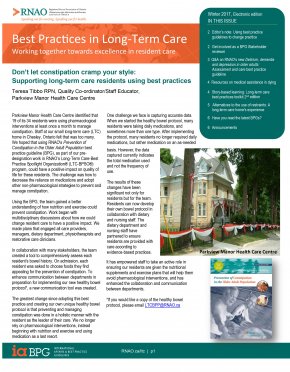Don’t Let Constipation Cramp Your Style: Supporting Long-Term Care Residents Using Best Practices
Parkview Manor Health Care Centre identified that 19 of its 34 residents were using pharmacological interventions at least once a month to manage constipation. Staff at our small long-term care (LTC) home in Chesley, Ontario felt that was too many. We hoped that using RNAO's Prevention of Constipation in the Older Adult Population best practice guideline (BPG), as part of our pre-designation work in RNAO’s Long-Term Care-Best Practice Spotlight Organization® (LTC-BPSO®) program, could have a positive impact on quality of life for these residents. The challenge was how to decrease the reliance on medications and adopt other non-pharmacological strategies to prevent and manage constipation.
Using the BPG, the team gained a better understanding of how nutrition and exercise could prevent constipation. Work began with multidisciplinary discussions about how we could change resident care to have a positive impact. We made plans that engaged all care providers, managers, dietary department, physiotherapists and restorative care clinicians.
In collaboration with many stakeholders, the team created a tool to comprehensively assess each resident’s bowel history. On admission, each resident was asked to choose foods they find appealing for the prevention of constipation. To enhance communication between departments in preparation for implementing our new healthy bowel protocol*, a new communication tool was created.
The greatest change since adopting this best practice and creating our own unique healthy bowel protocol is that preventing and managing constipation was done in a holistic manner with the resident as the leader of their care. We no longer rely on pharmacological interventions, instead beginning with nutrition and exercise and using medication as a last resort.
One challenge we face is capturing accurate data. When we started the healthy bowel protocol, many residents were taking daily medications, and sometimes more than one type. After implementing the protocol, many residents no longer required daily medications, but rather medication on an as-needed basis. However, the data captured currently indicates the total medication used and not the frequency of use.
The results of these changes have been significant not only for residents but for the team. Residents can now develop their own bowel protocol in collaboration with dietary and nursing staff. The dietary department and nursing staff have partnered to ensure residents are provided with care according to evidence-based practices.
It has empowered staff to take an active role in ensuring our residents are given the nutritional supplements and exercise plans that will help them avoid pharmacological interventions and has enhanced the collaboration and communication between departments.
*If you would like a copy of the healthy bowel protocol, please email: LTCBPP@RNAO.ca
By Teresa Tibbo RPN, Quality Co-ordinator/Staff Educator, Parkview Manor Health Care Centre
This article is reprinted from RNAO's Best Practices in Long-Term Care Newsletter Winter 2017 edition with permission